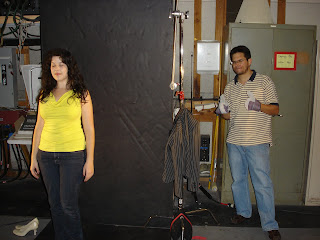Wednesday, February 24, 2010
Miniature used to create a space for live action set.
Placing live action set inside miniature to create a space that would be difficult to locate or create full size, such as a castle or antique house. Forced perspective and miniature set put to use in this shot.
Front Projection "Scotch-Lite"





Attaching "scotch-Lite" material to props, miniatures, an actors creates glowing effect with small amounts of light positioned at camera lens. "Scotch-light" can also be used for full size screens for projecting backgrounds or green screen capture. Up to 95% of light falling on "Scotch-Light" is reflected back to camera when camera lens and projected light source are "on axis".
Practice Quiz
Practice Quiz Front Surface Mirror Technique
1. A FRONT SURFACE MIRROR is used to combine TWO images in one photographic pass.
2. To set up a TAPE SPLIT set the iris to a HIGHf/stop for aligning the tape segments.
3. When shooting a SPLIT SCREEN MATTE the exposure adjustment is ZERO stops.
4. When shooting a 50/50 FRONT SURFACE MIRROR shot, adjust the exposure by
OPENING_ the iris by ONE stop(s).
5. To BACK WIND THE BOLEX:
a. DISCOUNECT The motor selector
b. ENGUAGE the run switch
c. CLOSE the fader lever
d. CLOSE the eye piece light trap
6. When shooting a MATTED SPLIT FRAME SHOT always LOCK-off the tripod head.
7. Any camera movement, while back winding the film in the camera, will cause the subsequent pass to be OUT of register when shooting split screens.
8. To insure the focus of the near object and the far object in a FRONT SURFACE MIRROR shot, one should consult the ASC Manual for a HYPER FOCAL calculation.
9. How much light is lost when shooting THROUGH a front surface mirror? ONE FULL stops.
10 How much light is lost when shooting off the front surface of a front surface mirror? ONE FULL STOP stops.
Practice Quiz Front and Rear Screen Projection
1. The big advantage to rear screen process system is, a combining of foreground with background without a matte line.
- Care must be taken in rear screen projection to avoid an alignment of the projector bulb with the camera lens. A hot spot on the screen will be visible.
- Front projection, utilizing Scotchlite material, can be accomplished in a fully lit stage.
- The reflectance value of Scotchlilte material is approximately 95% at the camera lens.
- Stuart Film Screen Company in Torrance California manufactures rear screen material.
- Light readings for rear screen projecting are taken with a spot meter off the screen with no film in the projector.
- Three prints are made, at a minimum, for process projection on the set.
- There are three ways to synchronize the film pull-down in the projector with the closing of the camera shutter. They are, mechanical flex cable, 24p port from the camera system to the projector, and interlock with selson motors.
- Flicker can be eliminated in the Arris-S non-sync system by adjusting the camera speed while viewing the screen through the eyepiece.
- Scotchlite material can be used to create, running lights on miniatures, Glowing objects on actors and set pieces and screens on watches, televisions and radar screens.
















